Fashion Prints
Morning Dresses • Walking Dresses • Carriage Dresses • Riding Habits • Half Dress • Full Dress • Court Dress • Bridal Dresses • Mourning Attire • Sea Side Fashions • Hats • Gentlemen's Fashion
Morning Dresses

Morning Dress, Overview

Many fashion prints of the Regency period are labeled “Morning Dress.” This does not designate a specific type of dress. The “morning” label designates nothing more than the time of day the ensemble was worn.... Read More →
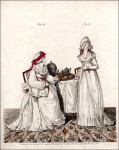
Morning Dresses, November 1794
"A French night cap, the cawl of worked muslin, with a double border of lace in half plaits; round the head, a broad striped riband quilled, with a large bow behind, and in the front... Read More →
See all articles on Morning Dresses →
Walking Dresses

Walking Dresses, Overview
Walking Dresses were worn on outdoor occasions when one wanted to see and be seen. They are often referred to as Promenade Dresses, a very literal definition of their purpose. The fashionable Regency woman was seen walking in the parks or in the shopping districts during the London Season... Read More →

Morning Walking Dresses, May 1795
"Bonnet of yellow satin, lined with white, trimmed with a yellow band-feather, and a piece of yellow satin, forming a large bow in the front... Read More →
See all articles on Walking Dresses →
Carriage Dresses

French Walking or Carriage Costume, January 1802
The diamond-shaped back panel is seen on some female riding habits, and the pleats falling from the high waist are beautifully done... Read More →
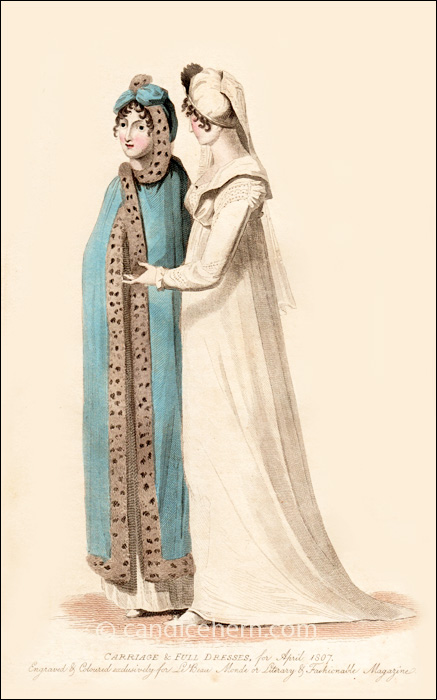
Carriage Dress and Full Dress, April 1807
"A CAPOTE A LA RUSSE, is composed of a mantle and head-dress in one, to cover the figure; it is made of sky blue velvet or silk... Read More →
See all articles on Carriage Dresses →
Riding Habits

Riding Habits, Overview
A distinctive equestrian costume for women, the riding habit, was first introduced in the 17th century. They were tailored by men in the manner of men's dress: a fitted jacket worn over a long skirt, often worn with a masculine hat.... Read More →
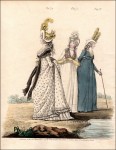
Walking and Riding Dresses, November 1795
"Round gown of muslin, embroidered in colours; long sleeves; double flounce at the bottom... Read More →
See all articles on Riding Habits →
Half Dress
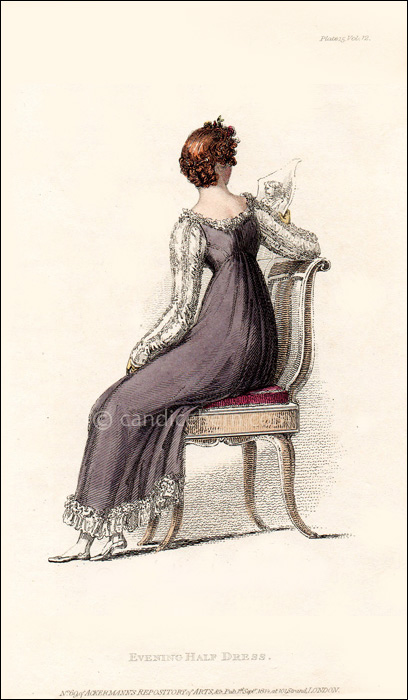
Half Dress, Overview
Half Dress follows the less formal morning dress and afternoon walking dress into the late afternoon and early evening, and sometimes later in the evening if the occasion was not strictly formal... Read More →
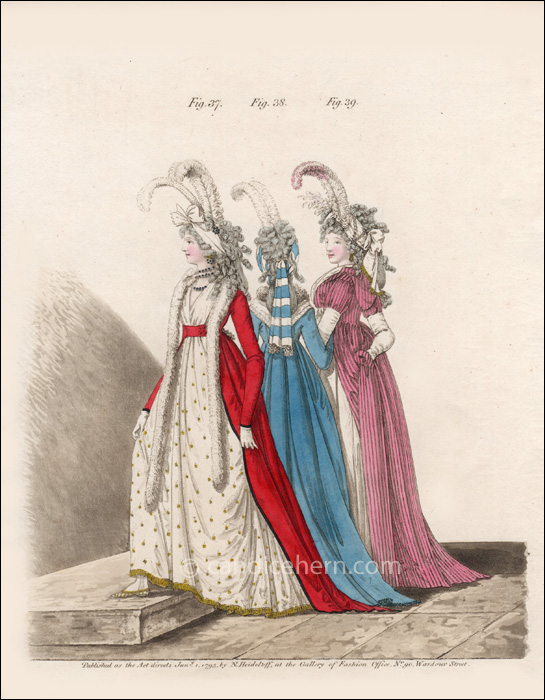
Afternoon Dresses, January 1795
"Robe à la Polonaise of cherry-coloured satin, bound with black velvet, long sleeves; olivets and chain down the back... Read More →
See all articles on Half Dress →
Full Dress

Full Dress, Overview
Full dress would have been the most formal of all evening wear, for both men and women. Full dress was worn only for very formal occasions, such as a ball or a formal reception or party. For women, prints labeled “Evening Dress” or “Ball Dress” would fall under the umbrella of Full Dress.... Read More →
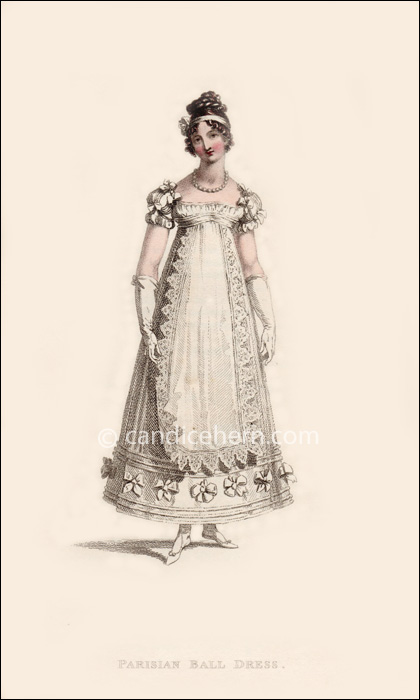
Ball Dress, April 1817
"A frock of white tulle over a white satin slip; the upper part of the body is formed of a piece of tulle set in full, the lower part plain... Read More →
See all articles on Full Dress →
Court Dress
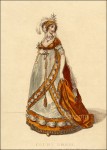
Court Dresses, Overview
When ladies (and gentlemen) appeared at Court on formal occasions they were required to wear Court Dress, which was a very formal, very specific type of garment that was not worn anywhere else.... Read More →
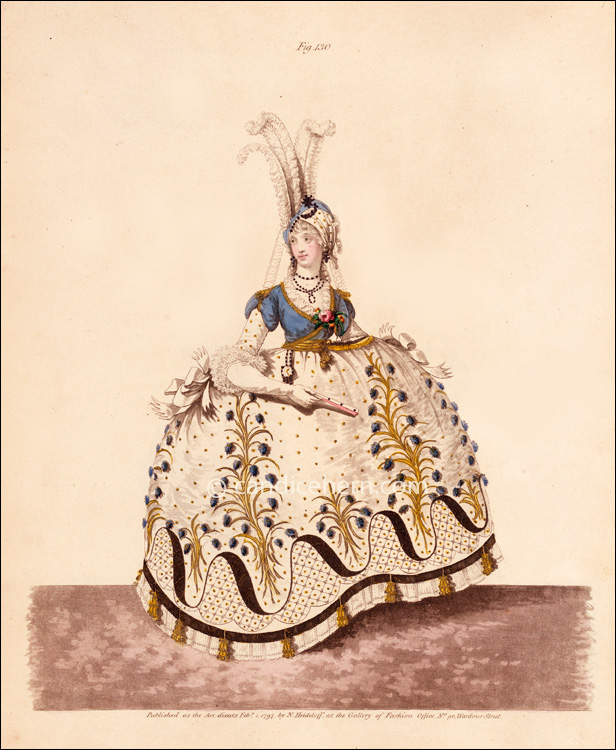
Court Dress, February 1797
"White crape petticoat, magnificently embroidered in purple, black, and gold; deep white fringe, headed by a black velvet ribband, ornamented with gold tassels... Read More →
See all articles on Court Dress →
Bridal Dresses

French Bridal Dress, September 1813
A lace dress over an underskirt trimmed with flowers at the hem. The waist is quite high... Read More →

Bridal Dress, June 1816
"A frock of striped French gauze over a white satin slip; the bottom of the frock is superbly trimmed with a deep flounce of Brussels lace... Read More →
See all articles on Bridal Dresses →
Mourning Attire
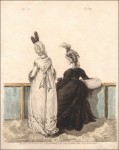
Full and Half Mourning Opera Dresses, December 1796
"Round gown of thick plain muslin, embroidered in black; short close sleeves, trimmed with black lace. Small muslin shawl, the border embroidered in black... Read More →
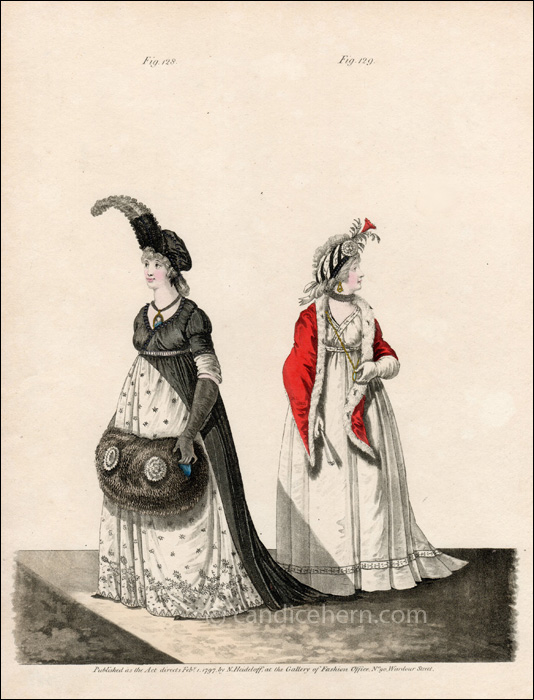
Half-Mourning Half Dresses, February 1797
"Petticoat of lawn, richly embroidered in black. Robe of black muslin, trimmed round the neck down to the girdle with pearls... Read More →
See all articles on Mourning Attire →
Sea Side Fashions
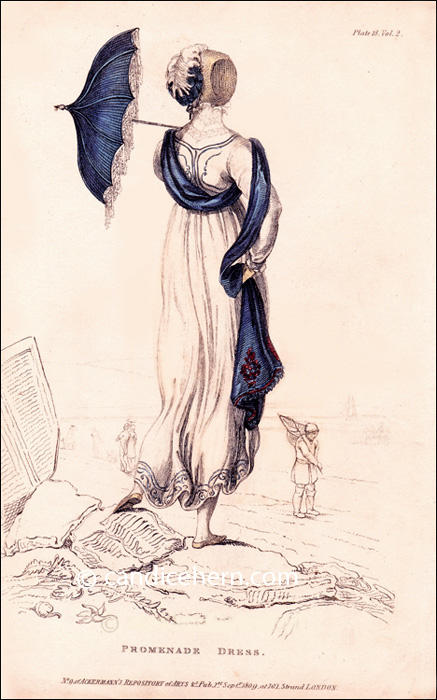
Promenade Sea Beach Costume, September 1809
"A Grecian frock of fine French cambric or jaconet muslin, with corresponding border at the feet, in shaded purple embroidery; Roman back and front of the same.... Read More →

Sea Coast Promenade Dress, October 1809
"A bonnet composed of yellow satin and lace, richly embossed with leopard spots in deep orange; the front in the tiara form, bound with green figured ribband... Read More →
See all articles on Sea Side Fashions →
Hats

Hats, May 1799
"Turban en ruche. This head dress, which takes its name from a beehive, has been made up of deep red gauze, upon a white ground... Read More →

Hats, September 1799
"Turban of cambrick muslin and purple sattin.... Read More →
Gentlemen's Fashion

French Gentleman’s Evening Dress, February 1801
The coat is cut high in the waist, as was typical of this period, although this example is a bit exaggerated in the manner of the Incroyables... Read More →
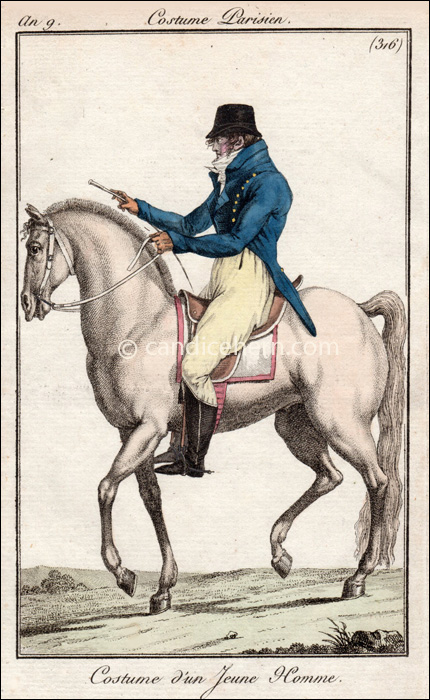
Gentleman’s Riding Costume, July 1801
This young man looks like he might have been one of the Incroyables... Read More →
See all articles on Gentlemen's Fashion →